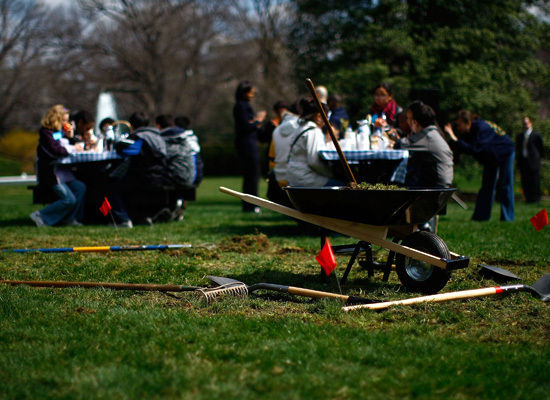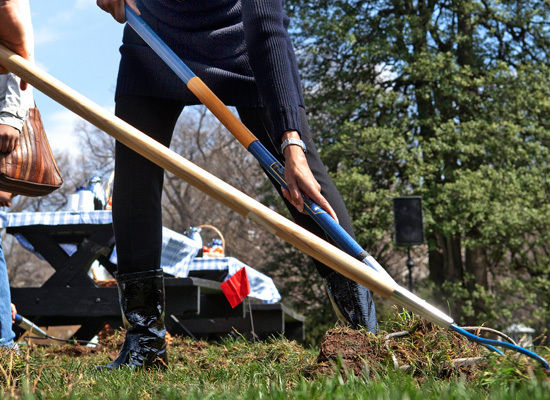Sir Paul McCartney’s ex-wife Heather Mills has landed a lucrative deal to promote vegetarian food for fast food chain Burger King.
According to the UK’s The People, the 41-year-old former model has apparently inked a 4.3 million dollars deal to promote Burger King’s new meat free burgers at the company’s 11,350 outlets throughout the world.
“Heather is ecstatic, Contactmusic quoted a source as saying.
“She believes she can change the eating habits of millions. She’s also being paid a lot of money and the deal will help boost her standing,” the source added.
Mills was reportedly chosen for the role after she donated one million dollars of free veggie burgers to poor kids in New York last year.
Kitchen Garden Tips: Be Like Michelle Obama!
Does the country feel a little healthier today to you? A little more frugal? Maybe it's because First Lady Michelle Obama broke ground on a White House "kitchen garden" today. Maybe you're inspired by that -- or just by skyrocketing seed sales all across America. Either way, here's a quick guide to get you started growing your own food.
KITCHEN GARDENING TIPS
1. Tap into your community. People around you can help answer questions specific to your area. Ask at your local nursery or farmer's market about what will grow well in conditions you have access to -- and make sure it's something you'll actually eat!
2. Start small. If you've never gardened before, or if you don't have much room to work with, try this great guide to growing strawberries at home.
3. Get your soil for free!
4. Composting helps your plants, helps you connect to nature and helps cut down on waste! There are tons of guides to this. Try starting here.
5. If it's still too cold where you are, you can start your plants indoors -- and you can even use the help of ultra-efficient LED lights.
And Treehugger has a whole set of gardening tips directed at the Obamas, too!


I can only hope that the first lady's next project is on the White House roof -- she did look at a few exhibits on solar power and rooftop gardening, after all!










KITCHEN GARDENING TIPS
1. Tap into your community. People around you can help answer questions specific to your area. Ask at your local nursery or farmer's market about what will grow well in conditions you have access to -- and make sure it's something you'll actually eat!
2. Start small. If you've never gardened before, or if you don't have much room to work with, try this great guide to growing strawberries at home.
3. Get your soil for free!
4. Composting helps your plants, helps you connect to nature and helps cut down on waste! There are tons of guides to this. Try starting here.
5. If it's still too cold where you are, you can start your plants indoors -- and you can even use the help of ultra-efficient LED lights.
And Treehugger has a whole set of gardening tips directed at the Obamas, too!
Here's Michelle Obama starting the project:


WHAT WILL BE IN THE OBAMAS' GARDEN?
According to AP, the White House kitchen garden is pretty ambitious, with "spinach, broccoli, various lettuces, kale and collard greens, assorted herbs and blueberries, blackberries and raspberries."I can only hope that the first lady's next project is on the White House roof -- she did look at a few exhibits on solar power and rooftop gardening, after all!










“Herbs in Himalayas can control Type 2 diabetes”
London: A Belfast-based scientist has claimed that a herb found in the Himalayan region could be effective in controlling Type 2 diabetes.
Dr. Yasser Abdel-Wahab, a senior lecturer in Biomedical Sciences at the University of Ulster, and his team discovered that the roots of a cucumber-like vegetable — a herb found in the forests of India — and extracts from the bark of a Himalayan plant, all showed positive results in test cases.
Stimulate Insulin production Dr. Abdel-Wahab said that following early laboratory work carried out on the Northern Ireland-based campus, researchers discovered the bark of Swertia chirayita, a plant traditionally grown in the Himalayas and also known as chirette, indicated that some compounds extracted from the bark appeared to stimulate insulin production and improve its action.
More study “Natural anti-diabetic drug discovery is a key area of research that is attracting a lot of interest.
“More research is needed to establish definitively how and if our findings could be translated into new therapeutic agents for treatments for people with Type 2 diabetes, but we are hopeful that this will one day be the case,” Dr. Abdel-Wahab told a conference in Glasgow.
Several teams of scientists across the United Kingdom have been investigating a range of weird and wonderful complementary therapies that have the potential to help treat Type 2 diabetes.
Dr. Yasser Abdel-Wahab, a senior lecturer in Biomedical Sciences at the University of Ulster, and his team discovered that the roots of a cucumber-like vegetable — a herb found in the forests of India — and extracts from the bark of a Himalayan plant, all showed positive results in test cases.
Stimulate Insulin production Dr. Abdel-Wahab said that following early laboratory work carried out on the Northern Ireland-based campus, researchers discovered the bark of Swertia chirayita, a plant traditionally grown in the Himalayas and also known as chirette, indicated that some compounds extracted from the bark appeared to stimulate insulin production and improve its action.
More study “Natural anti-diabetic drug discovery is a key area of research that is attracting a lot of interest.
“More research is needed to establish definitively how and if our findings could be translated into new therapeutic agents for treatments for people with Type 2 diabetes, but we are hopeful that this will one day be the case,” Dr. Abdel-Wahab told a conference in Glasgow.
Several teams of scientists across the United Kingdom have been investigating a range of weird and wonderful complementary therapies that have the potential to help treat Type 2 diabetes.
Can't get to sleep? Stay up

Reuters
STAY UP: Researchers at Auckland University have discovered a potential breakthrough treatment for insomnia.
Researchers at Auckland University have discovered a potential breakthrough treatment for insomnia that is cheap, effective and could spell the end of sleepless nights for hundreds of thousands of Kiwi insomniacs.
And paradoxically, the key to the treatment is to force bad sleepers to spend less time in bed.
The treatment is a kind of talking cure a technique so simple it can be taught to patients by GPs or practice nurses, and which can free insomniacs from their dependence on sleeping pills.
Patients are first told to keep a detailed diary of the time they spend in bed asleep and awake. They are then told to change their habits, reducing the time they spend in bed each night by the number of hours they would usually spend lying awake. After a couple of weeks of this sleep "deficit", many patients discover they are tired enough to start sleeping better.
The team has just completed analysis of a pilot study into the treatment. The results were impressive and have already excited interest from the prestigious British Medical Journal, which has published details.
Senior lecturer Tony Fernando, who led the study, said the results had huge public health consequences if adopted by GPs.
"It means the millions we spend on drugs, herbal medicines and special mattresses looking for an answer can actually be solved by something very simple."
Fernando's study of 40 participants over two years targeted primary insomniacs those whose insomnia has no obvious cause such as depression, anxiety or other sleep disorders.
It is believed up to 10% of New Zealanders some 400,000 people may suffer from primary insomnia.
When the insomniacs in Fernando's study underwent a four-week "sleep rescheduling protocol", 80 to 90% said their insomnia had improved. This result was so overwhelming Fernando was able to conclude the technique worked even though the study had a relatively small sample size.
For the first two weeks of the treatment, study participants were required to complete a sleep diary. "From that we estimate the actual total sleep time, which is different from the total time spent in bed." Typically a patient would spend eight or nine hours in bed but sleep for just five.
Patients were then instructed that for the next two weeks they were allowed to stay in bed only for the duration of their sleep time.
"If they were only sleeping for five to six hours, they were only allowed to stay in bed for a maximum of six hours. It is counter-intuitive people with sleep problems often spend longer in bed and go to bed early hoping to get to sleep.
"But if the brain is not ready to sleep, it won't sleep. This is about retraining the brain to sleep again.
"A lot of insomnia patients don't feel sleepy at 9, 10 or 11pm like most people. One way to make them sleepier is to delay bedtime. But people don't think like that; they think they should go bed earlier."
Fernando said if a patient followed the regime for two weeks, they would accumulate a sleep deficit that would reach a certain point where it would be strong enough to enable them to go to sleep.
Some study participants were so pleased with the results they dubbed them "a miracle cure", saying they slept better and had more energy.
A larger study, funded by the Health Research Council, targeting a broader range of participants has begun. It aims to improve the statistical significance of the original study, as well as pinpoint any side-effects.
The travelling man's eating plan
 Like most road warriors, diet was Sameer's last concern. "I was entering different time zones and dealing with job pressures. Once I met my deadlines, I just wanted to blow off steam." Then he sighs. "And the food at some places was delicious!" But Sameer attacked. He took our advice, revamped his diet, wedged workouts into his overstuffed schedule and lost 10kg in eight weeks. Now it's your turn. Every man is busy, every man is stressed and as a result, every man crashes into the same diet roadblocks. Simply put, travelling doesn't make you fat. Crappy food and crappier habits do. Rules of the road Any man who travels regularly needs a flexible, no-thought eating strategy-an effective diet that allows indulgence without calorie counting. The solution: a low-carb diet with benefits. Every time you eat high-carb foods-bread, pasta, rice, any product made with sugar or flour-the level of insulin in your blood rises. Insulin is a powerful hormone that signals your body to stop burning and start storing fat. How powerful? Jeff Volek, PhD, RD, a nutrition researcher at the University of Connecticut found that men who stuck to a strict low-carb diet for six weeks-without having to downsize portions-dropped an average of 3kg of fat and lowered their risk of heart disease. "We calculated that 70 per cent of the variability in fat loss was explained by the reduction in insulin levels," says Volek. Now think about that in reverse. If you're constantly downing carbs, you'll be in fatstoring mode all day. So adopt low-carb eating as your default diet and make high-carb meals an exception. You'll limit your number of daily insulin spikes, keeping your body in fat-burning mode most of the time.  Using the guidelines below, choose from the lower-carb group as often as you can. But when those foods aren't available, go ahead and enjoy selections from the higher-carb group. Use this rule: each time you choose a higher-carb food, try to have at least three lower-carb meals or snacks before dipping into that well again. What about alcohol? You can down up to two glasses of wine (300ml) or light beer (700ml) a night. 6 more ways to take a load off Forget about the menu: In restaurants, determine your order before you even see the options. Most people choose with their eyes and not with their heads. At dinner, for example, you should decide that you're ordering a salad as your appetiser (instead of bread), and chicken or fish with veggies. Be your own man: When ordering dinner with a group, don't follow the overeating crowd-it could benefit your career. "If your boss and colleagues see you eating healthy, you're going to look like an outcome-driven leader," says behavioural therapist Robinson Welch, PhD. It sends a message that you want to be successful. You'll take care of business as you take care of yourself-effectively. Manage temptation: When reserving a room at a hotel, ask for your mini-fridge to be stocked for a diabetic. Desk your laptop: "If you work in bed, you associate the bed with wakefulness and activity, not with sleep and relaxation," says Mark Rosekind, PhD, a former sleep scientist at NASA. Men average two to three fewer hours of sleep when they travel for business, and this disturbance in your internal clock decreases your levels of leptin (a hormone that delivers feelings of satiety) and increases the levels of ghrelin (a hormone that sparks hunger). The net effect: your appetite increases by 23 per cent. Invite a new client to dinner: Researchers at the State University of New York at Buffalo observed that men consumed 35 per cent fewer calories when eating with strangers than with friends. Keep a stash of protein bars, but use caution: Energy bars are typically designed for athletic performance, and often contain around 300 calories and lots of sugar.
| ||||
Food Advertisements: That Makes Us Buy

Food product choice is overwhelming as well as TV commercials and print advertisements that want to sell their food products to us. Who to believe? How to choose? Do you trust what is shown to you?
 Food product choice is overwhelming as well as TV commercials and print advertisements that want to sell their food products to us. Who to believe? How to choose? Do you trust what is shown to you?
Food product choice is overwhelming as well as TV commercials and print advertisements that want to sell their food products to us. Who to believe? How to choose? Do you trust what is shown to you?
Obviously, it’s up to each of us to decide what we eat but if we’re constantly bombarded with images of food every time we pick up a magazine then we’re going to be swayed in what we choose
So what’s behind the advertisements? I am not an expert but here are a few examples of tricky advertisements that sell food to us because…




























 Food product choice is overwhelming as well as TV commercials and print advertisements that want to sell their food products to us. Who to believe? How to choose? Do you trust what is shown to you?
Food product choice is overwhelming as well as TV commercials and print advertisements that want to sell their food products to us. Who to believe? How to choose? Do you trust what is shown to you?Obviously, it’s up to each of us to decide what we eat but if we’re constantly bombarded with images of food every time we pick up a magazine then we’re going to be swayed in what we choose
So what’s behind the advertisements? I am not an expert but here are a few examples of tricky advertisements that sell food to us because…
It is delicious:
Is it really as delicious as it looks? Here are just a few examples of what we see on the cover (left) and what we find inside (right photo):





It is better than anything:
Pepsi:

Dunkin Donuts:

It is relaxing:
Heineken:

Break tout Choco: “Have a chocolate break“

It is right for you:
Susu Cimory/Cisarua Mountain Dairy:

Negroni: “A world cut out for you“

Masterfoods Bounty Chocolate: “Two pieces of paradise“

It makes you better:
McDonald: “Wake up with the premium roast coffee“

PowerBar: “Increase Your Performance“

It is natural:
New York Fries: “Real Fries in a Fake World“

Big Gulp ice cream: “Have a bite of nature’s delight“

Nejma Sunflower Cooking Oil:

It is fun:
Pepsi Twist:

It defends you:
Verum Halsofil: “Army 100 billion good bacterias to defend your stomach“

It is cool:
McDonald’s:

Tiger Beer:

Masterfoods Skittles:

Perrier:

It is HUGE :
Snickers:

It is what you want it to be:
Miracel Whip: “Only 4,9% fat“

Heinz: Thick

Heinz Fit Ketchup: “No sin. More tomatoes, less sugar“

Source: Ads Of the World, post image by superbez
Subscribe to:
Posts (Atom)